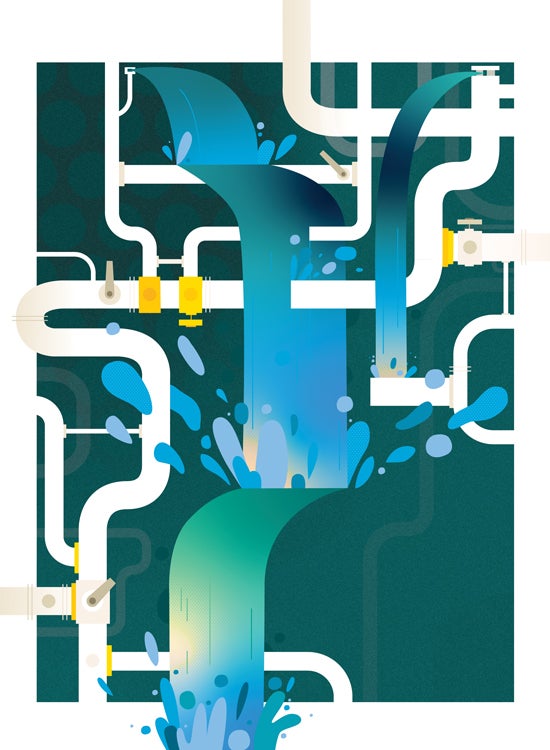Connecting Water Supply and Sanitation
Scientists have discovered a way to turn wastewater into a valuable resource.

Fall 2025
By Alex Becker
Illustration by Alex Eben Meyer
Traditional, centralized water infrastructure — long considered the backbone of modern civilization — is costly to build, difficult to expand and increasingly vulnerable to climate disruption, population growth and aging materials. Environmental engineer Qilin Li is pioneering a new way to manage wastewater at the most local of levels — the household. Together with Arizona State University and funded by the Gates Foundation, Li and the Rice WaTER Institute are designing and building sustainable systems that integrate water supply and sanitation, eliminating the need for traditional sewer lines.
The Problem: A System Under Strain
Globally, billions of people live without access to sewer systems or safely managed drinking water.
“We don’t think the current way of supplying water and managing wastewater is sustainable,” says Li, professor of civil and environmental engineering in the George R. Brown School of Engineering and Computing at Rice and lead for the Rice WaTER Institute’s Decentralized Reuse Enabled by Autonomous Modules initiative.
This disparity is especially stark in low-income countries, where a lack of infrastructure, a warming climate and rapid urbanization compound the problem, fueling disease, malnutrition and environmental degradation.
“We often treat water supply and sanitation as two separate issues,” says Li. “But in reality, they’re deeply connected. In water-scarce regions, wastewater isn’t waste, it’s a valuable resource.”
When wastewater is treated properly and reused locally, it doesn’t just ease the strain on infrastructure, it boosts water security, supports sustainability and provides essential services to communities that have long been left behind.
The Research Plan: Rethinking From the Ground Up
The project tackles two core streams of wastewater. The first is urine treatment, which focuses on recovering nitrogen, phosphorus and potassium — key nutrients for fertilizer — while also disinfecting and recycling the water for toilet flushing. The second is greywater treatment, which targets the lightly used water from sinks, showers and laundry to be cleaned and reused for handwashing or other non-potable applications.

When wastewater is treated properly and reused locally, it doesn’t just ease the strain on infrastructure, it boosts water security, supports sustainability and provides essential services to communities that have long been left behind.
Instead of relying on complex and fragile biological treatments or the chemically intensive treatments traditionally used in municipal plants, Li’s team uses electricity to disinfect and purify water through electrodialysis and electrochemical disinfection, technologies that can be fully automated and operated without specialized training.
The Potential Impact: Local Systems, Global Reach
These household-scale systems are more than engineering feats — they’re tools for equity and resilience, with a utility that extends beyond developing regions. Aging infrastructure in major cities is beginning to present major challenges, and in places where expanding or replacing sewer networks is cost-prohibitive, stand-alone, self-contained sanitation systems offer an elegant work-around. Public restrooms, for instance, could be deployed quickly and affordably without tearing up streets for new plumbing.
“If we can recycle water on site, we reduce dependence on centralized systems and reduce the costs and risks that come with them,” Li says. “The systems being designed are modular and reconfigurable, which means they are customizable to different water needs, cultural preferences and environmental constraints.”

The Professor: A Personal Path to Public Good
For Li, the motivation to change the water paradigm is rooted in experience. Growing up in China, she boiled every drop of water before drinking it. When she moved to the U.S. and saw people drinking straight from the tap, it was a revelation — and the beginning of a lifelong mission.
“I remember thinking, this is amazing, being able to trust your tap water,” Li recalls. “But over time, I realized that even these systems have flaws.”
Li has spent nearly a decade designing flexible, high-performance water technologies with global reach in mind. “There’s no one-size-fits-all solution,” Li says. “Water is technical, but it’s also cultural. What works in India may not work in Texas.”
Her early interactions with the Gates Foundation involved reviewing other projects around the world, from toilets in the U.K. to treatment units in Thailand. That experience, she says, was deeply eye-opening.
“You begin to see that sanitation isn’t just a technology issue. It’s about perception, trust and economics,” she explains. “In some cultures, collecting waste is stigmatized. In others, it’s a business opportunity.”
Today, she’s applying those lessons to design systems that are not only technically sound but socially and economically viable. “We’re not just building hardware,” Li says. “We’re building a new model for how the world thinks about water.”
